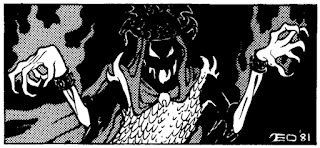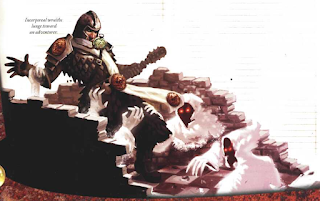One of the more well-known products of the OSR movement is James Raggi's
Death Frost Doom. Near the end of that adventure, there is the possibility of something rather... bad happening. (Well, more than one, but there's one in particular that I'll focus on). One thing that I've been wondering about is what it would take to stop it. (SPOILERS below: stop reading here if you want to avoid them!)
Specifically, there is the possibility in
Death Frost Doom of an enormous horde of undead being "vomited" forth to raze the countryside. The total number is over 12,000 bodies, which is indeed a huge mass -- that's probably about as many as it took to conquer England in 1066; and it exceeds the total size of most middle-ages towns. By medieval standards you'd need a very large national army to meet it in combat and hope to defeat it (and if you lose: well, then that's probably a lot more ghouls being spawned).
Although we have previously presented
statistics for the lesser undead present, the overall number is really larger than a 1:10 scale wargame like
Book of War is set up to handle. Nevertheless, I wanted to see generally how this action would play out. Let's say a portion of the overall group, say about 1/20 of the total, has splintered off and wandered into an unknown far-east kingdom. This will be pretty close to 300 points value in
Book of War, which is what I offered to my regular opponent to choose for an army. See below for how that played out (and more about the full force at the end):
Start -- 310 Points; Optional Rules for Weather & Morale in play. At the bottom of the table you'll see that I have a core group of 10 Ghoul figures in the center, with 10 Warrior Zombies (2HD) to the left, and another 40 Common Zombies (1HD) in groups on the wings & rear (thus representing individual 100 ghouls, 100 warrior zombies, and 400 commoner zombies).
At the top of the board, you'll see that my opponent has elected to take a group of almost all
War Elephants, with archers on the back (plus a small group of Pikes for 10 points). This is somewhat surprising, since she tried to use War Elephants and Pikes the last time I threw an all-undead horde at her, and they were overwhelmed and destroyed rather handily in that engagement. (
See that play here.) Here, the Elephants are an even sweeter target for the Ghoul's paralysis ability; while they normally have 6HD, any single hit from the ghouls will wipe out an entire figure immediately (as long as a follow-up roll gets d6≥3). But my opponent feels that she has a better idea on how to use the Elephants this time, so, hey, let her dig her own grave, I say. (Photos are a bit hazy from my overhead lamp being busted the other week, apologies for that.)

Before I go further, I should point out the rather important roll for weather (which happened right before army setup above). If the weather is Sunny, then my ghouls will be at -1 to hit in the light (for example: instead of hitting elephants on a 5, they'll need a 6). So: My opponent rolled a "7", which is the last possible number she could roll and still get Sunny weather.

Turn 1 -- My undead lumber forward at their full move rate (the ghouls a bit faster then the rest). Then my opponent makes half-moves with her forces, which allows the archers to take half-dice shots. I lose a few zombie figures on each wing. Normally this would trigger Morale checks, but of course, all of my undead forces are immune; so, that won't be any factor at all in this game.

Turn 2 -- My forces again lurch ahead relentlessly. (Tip: The opponent really appreciates it if you mumble "brains...." every time you push forward a stand of undead.) In response, the war elephants lower their heads and charge forward, crashing into my lines. Here's what happens there: the elephants get 2 attacks each, and they automatically hit my zombies (armor AH4, but elephants at +3 to hit, so they hit on any die-roll 1 or above). My warrior zombies have 2HD, but the friggin' elephants also get 2 damage, so they're automatically killed, as well. Plus the archers get some half-dice shooting as well. Holy crap, that's a lot of carnage! (Side note: This is actually
toned down from how elephants are listed in the AD&D MM, where they would instead get
five attacks for two dice each.)

Turn 3 -- My remaining zombies wrap around the enemy, and score between 1 and 3 hits each on the elephant units, and I've got more zombies coming down the hill on the far right. My ghouls in the center start wheeling to the left to threaten the main elephant force there, with more zombies behind. In response, the enemy throws her pikes forward, into the flank of the ghouls (scoring 1 hit). This is a pretty astute move, because it will prevent the ghouls from maneuvering unless they turn and flee directly away (back into the woods). Meanwhile, the elephants are mostly stamping out the remaining zombies directly in contact with them.

Turn 5 -- My ghouls had to take a turn to kill and devour the pikemen, then re-face and finally wheel out of the woods; the far-left elephants have turned and are shooting at them long-distance. Zombies on the far-right tried to attack the elephants there, but came up 3/8 of an inch short on the table (there was argument here, didn't go my way), and then half their numbers went down to trampling war elephants. Still more zombies in the woods waiting for a chance to attack their rear, however.

Turn 6 -- My ghouls charge the elephants at last, achieving contact by the slimmest of margins. I get 3 figures in contact, and thus 3 attacks; any hit is more than likely to wipe out an entire elephant figure, so this is the key moment that I've been eagerly awaiting. However, with the Sunny weather, I do need to roll a "6" on any attack die to succeed. My numbers come up: 2, 2, and 2. On my opponent's turn, her elephants come running at me and immediately
smash the entire ghoul unit into a fine, gray paste. Well, holy damn.

Turn 8 -- My remaining zombies surge out of the woods on the far right, into the rear of the elephants unit there, and do manage to take down one figure (due to elephant's high HD, they would only fail morale on a 2d6 roll of 2, which does not happen). Then on the next turn, they wrap around and rack up another 5 hits (1 hit shy of eliminating another figure). But at this point the opponent has brought her units from the other side into the fray, and wipes out all my remaining figures. Victory to the Elephant Queen!

Commentary -- This play surprised the heck out of both of us; we really both went in thinking I had the advantage, and my opponent made my complete defeat look rather easy. A few thoughts: (1) If you add up the excess hits on the elephants, I was pretty close to knocking out two more elephant figures (about half her army), so perhaps it was a bit closer than it first seemed. (2) I might have made a terrible mistake sending my Ghouls into the central woods -- the idea being to protect them from missile-fire and permit them the threaten either side, but I guess they just don't have the movement to avoid getting bogged down there. (3) There's a bit of an open question if the War Elephants are possibly under-priced; that might need a bit more investigation.
But it is true that the zombies and ghouls, with slow movement and no missile weapons, clearly have some weaknesses that can be exploited by a clever opponent. And apparently an excellent response is to bring about 60 War Elephants to the field for every 600 or so Lesser Undead. My opponent really did learn a major lesson from her earlier force of Elephants; against these undead, they're best used aggressively, smashing over the enemy lines and crushing them into powder at the earliest possible opportunity.
Speaking of the larger horror-show that can occur in
Death Frost Doom (again; this was just 1/20 the total force), the overall numbers run approximately 2,000 Ghouls, 2,000 Warrior Undead, and 8,000 Common Undead (in round numbers); and that's about 6,000 points value in
Book of War. By my calculations, an equivalent force might look like an army of 1,000 Heavy Cavalry, 2,000 Longbowmen, and 4,000 Pikemen. If your fantasy-medieval kingdom has those forces available, and you've got upwards of 2,000 miniature figures and a mammoth table, then you might consider playing out the whole thing in a titanic
Book of War game. Or you can use action against smaller splinter-groups, possibly with high-level PCs leading the undead into favorable terrain or enveloping traps, somewhat as you see above. And may you always make your paralysis saves!



























